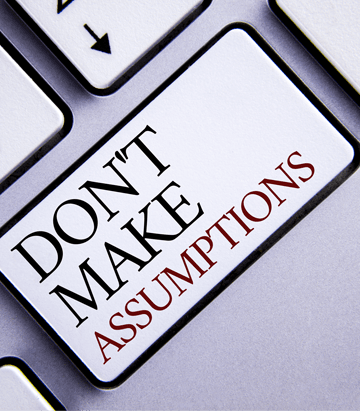In B2B, you simply don’t have the luxury of gaining full data sets, inferences, heat mapping analysis, and the other KPIs you can gather from an online e-commerce business.
Most of B2B sales is human interaction, longer sales cycles, and a blend of soft and hard data points. This makes it essential to capture front-line intelligence while conducting tasks within the sales cycle. This data and information is not just for the individual sales executive’s use, but also for senior management to identify trends across the entire sales team and determine what’s working – and just as importantly, what is not.

A critical gap always lies between management’s inferences, assumptions, and proposed changes, and what will actually test better on the front lines. There are many reasons for this, including inaccurate data collection, inaccurate inference assessment, misaligned assumptions, incorrect tactics, the highly subjective nature of how sales messages and collateral are received (variables like the messenger, the message, the context, the relationship strength, other competitive bids, the client’s situation), and also bad judgement from sales a layer removed from the front-line. All of these can impact final decisions in a significant way.
The best way to ensure that the various inferences and assumptions hold true is to move toward an evidence-based approach, where seeing is believing. This allows you to actually test the assumptions in reality before scaling it across the entire business. This feedback may take the form of an initial representative sample set focus group, where a set of prospective clients are invited to partake in this exercise, and are incentivized to do so, where they provide real-time feedback on a set of essential questions and discussion topics.
Many assumptions, inferences, new designs, and messaging will be tested and assessed. Focus groups, whether conducted in person or digitally, require time and budget to be done professionally. And for some, it may make more sense to live test variations of the final sales assets in the field. Focus groups come with some inherent biases, most notably that how people say they will respond and behave when presented with new sales collateral is not what actually happens in real life. That is, you could test one executive with variations of sales collateral and messaging, and what they say they would most favorably respond to is totally different when that same executive is being presented those new assets in a live real setting. This is why live field testing is a must, even after doing a focus group test, as both have benefits.
From the test results, there should be a clear direction, one approach that tests the best across the various directions of collateral. Once you have identified it, pick the most optimal and test it again with a larger sample set (5-7 times the size of the first set). Determine if the results are proving as optimal as when tested in the smaller scale and, if so, apply them across the entire sales team. Be sure to closely monitor the various results across the KPIs to ensure you can quantify the improvement. Please note: it’s not as simple as just testing new assets across actual potential buyers, but also how do you conduct the tests, come up with valid inferences, and subsequently apply them to create winning new sales collateral.
If the initial test actually does not show one direction being significantly better performing than another, then it may be necessary to go back to the sample set and get into the “why” of it all. Why is something more attractive than another? Why are these claims more compelling than those? Why would you buy when presented this versus that? Maybe the assets are calibrated for what you initially assumed the audience would respond to. With a better understanding their core reasons of “why” they are making buying decisions , you can recalibrate again to reflect these new insights. Getting to the bottom of the core issue, and figuring out the most optimal way to then take that insight and convert it into new stunning sales collateral that tests well is both an art and a science.
With this new context, here are 3 reasons why the future of branding and sales is evidence-based:
1. Efficacy [Lean Data Please]
The primary reason to adopt an evidence-based approach is to ensure that new assets are indeed far superior to the initial sales collateral. That is, that there is efficacy and they actually work better as promised. Evidence-based means that new sales collateral/process/systems have been tested, and re-tested, to ensure that they indeed yield far better results than the originals did. Efficacy is the reward from all the work that goes into creating new evidence-based assets.

Secondly, in a world of BIG data overload, where we are seeing a need for marketing and sales professionals to suddenly become data scientists, a new trend of lean data is arising. Having hundreds of data points across the sales process may be nice, but what counts will never change: how effectively are you at Capturing, Compelling, and Closing the target? How do you scale sales conversion improvements across the entire sales team? If this is indeed the most important end-state to have data about, then you need to filter BIG data down to the lean data that will solve for this primary focus.
2. Scale Success
Without having evidence-based sales collateral, you are taking a risk in assuming your own internal understanding of what works and doesn’t with the existing sales collateral is accurately correlated to the way your target client views everything. This assumption is then used to subjectively interpret the necessary changes on the minute detail level for new asset creation, for example, taglines, sentence structure, brand messaging, design, color pallet, layout, content volume, sales story, calls to action, and imagery.
When these existing assets are replaced with the new, untested assets, one of three things happens: sales go up, sales go down, or nothing happens. When sales go down, or nothing happens, there is obvious confusion and they are declared a failure with more assumptions added on for good measures. When sales go up, there’s a celebration. It should be celebrated, but the concern is whether that 7.23% increase in overall sales was the optimal lift? Are you leaving an additional 10% , or even 15%, on the table? And it’s highly unfortunate for those left confused when sales actually went down or did nothing, as there was a much better approach available.
Scaling success with an evidence-based approach allows for a far higher confidence in the response direct potential clients have to these assets. This is proven, not assumed. This confidence then allows you to successfully scale sales success across the entire organization. For larger organizations with regional variances, this must be taken into account with slightly different collateral to maximize sales conversion with the same evidence-based approach.
3. Competitive Advantage
As you take market share away from your competitors, they may take note as to what’s happening. Upon reviewing your sales process, collateral, and approach (via secret shopping) they will assume it’s just because of your new polished sales collateral. They may redo their own collateral and garner some ideas from yours, but it will not perform the same as yours because it is not evidence-based. Your sales collateral is now also customized specifically for your sales team, each region, and the type of client you are prospecting.
When done correctly, evidence-based sales and marketing collateral is a distinct and formidable competitive advantage.

It’s worth noting that data-based decisions are as valid as the quality of the data and inferences being assessed. As with most things, quality in is quality out.
Lastly, evidence-based thinking and subsequent methodology is not static, but dynamic. What may have tested as excellent in Q1 could be very different in Q4. With this in mind, you may want to enact a “constant improvements” mindset. If your sales levels and growth allows it, implement evidence-based testing through the sales growth trajectory as a complementary parallel pathway to your main sales activity. This way you can make changes and adjustments, yielding better performance throughout the year and adopt an agile approach to all sales activities.

